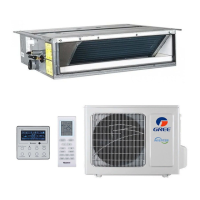outdoor units) with at least 3mm contact gap. The units must be able to be
plugged or unplugged.
③. Circuit breaker and power cord specifications listed in the above table are
determined based on the maximum power input of the units.
④. Specifications of power cords listed in the above table are applicable in a
working condition where ambient temperature is 40℃and multi-core copper
cable (e.g. YJV copper cable, with insulated PE and PVC sheath) is protected
by a conduit, and is resistant to 90℃ in maximum (See IEC 60364-5-52). If
working condition changes, please adjust the specifications according to
national standards.
⑤. Specifications of circuit breaker are based on a working condition where the
working temperature is 40℃. If working condition changes, please adjust the
specifications according to national standards.
⑥. Adopt 2pc of 0.75mm² power cords to be the communication cords between
indoor and outdoor units. The maximum length is 100m. Please select a
proper length according to local conditions. Communication cords must not be
twisted together. To be in compliance EN 55014, it is necessary to use 8
meters long wire.
⑦. Adopt 2pc of 0.75mm² power cords to be the communication cords between
wired control and indoor unit. The maximum length is 30m. Please select a
proper length according to local conditions. Communication cords must not be
twisted together. To be in compliance EN 55014,it is necessary to use 7.5
meters long wire.
⑧. The wire gauge of communication cord should not be less than 0.75mm². It’s
recommended to use 0.75mm² power cords as the communication cords.
3.3.3 Connection of Power Cord and Communication Cord
(1) For solid wires (as shown below):
1) Use wire cutters to cut off the wire end and then peel away about 25mm of
the insulation layer.
2) Use a screwdriver to unscrew the terminal screw on the terminal board.
3) Use nippers to bend the solid wire into a ring that fits the terminal screw.
4) Form a proper ring and then put it on the terminal board. Use a screwdriver

